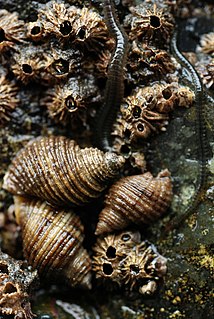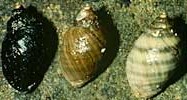
Mussel is the common name used for members of several families of bivalve molluscs, from saltwater and freshwater habitats. These groups have in common a shell whose outline is elongated and asymmetrical compared with other edible clams, which are often more or less rounded or oval.

A barnacle is a type of arthropod constituting the infraclass Cirripedia in the subphylum Crustacea, and is hence related to crabs and lobsters. Barnacles are exclusively marine, and tend to live in shallow and tidal waters, typically in erosive settings. They are sessile (nonmobile) and most are suspension feeders, but those in superorder Rhizocephala are parasitic. They have four nektonic larval stages. Around 1,000 barnacle species are currently known. The name "Cirripedia" is Latin, meaning "curl-footed". The study of barnacles is called cirripedology.

The blue mussel, also known as the common mussel, is a medium-sized edible marine bivalve mollusc in the family Mytilidae, the mussels. Blue mussels are subject to commercial use and intensive aquaculture. A species with a large range, empty shells are commonly found on beaches around the world.

The dog whelk, dogwhelk, or Atlantic dogwinkle is a species of predatory sea snail, a carnivorous marine gastropod in the family Muricidae, the rock snails.

Tide pools or rock pools are shallow pools of seawater that form on the rocky intertidal shore. Many of these pools exist as separate bodies of water only at low tide.

Acorn barnacles are one of the most common barnacle species on the Pacific coast of North America, distributed from the U.S. state of Alaska to Bahía de San Quintín near San Quintín, Baja California. They are commonly found in the upper intertidal zone on mussels, rocks and pier pilings. They can obtain oxygen from both water and air.
Acorn barnacle and acorn shell are vernacular names for certain types of stalkless barnacles, generally excluding Pedunculata. Depending on region and author, they could mean any of the following taxa:

Semibalanus balanoides is a common and widespread boreo-arctic species of acorn barnacle. It is common on rocks and other substrates in the intertidal zone of north-western Europe and both coasts of North America.

Amphibalanus improvisus, the bay barnacle, is a species of acorn barnacle in the family Balanidae.

Nucella canaliculata, commonly known as the channeled dog winkle or the channeled purple, is a species of sea snail, a marine gastropod mollusk in the family Muricidae, the murex snails or rock snails. The shell grows to a maximum length of about 4 cm (1.6 in). This species is distributed in the northeastern Pacific Ocean from the Aleutian Islands to California.

Nucella emarginata, common name the emarginate dogwinkle, is a species of medium-sized predatory sea snail, a marine gastropod mollusk in the family Muricidae, the murex snails or rock snails.

Nucella lamellosa, commonly known as the frilled dogwinkle or wrinkled purple whelk, is a species of sea snail, a marine gastropod mollusk in the family Muricidae, the murex snails or rock snails. This species occurs in the eastern Pacific Ocean, its range extending in the intertidal zone from the Aleutian Islands southward to central California.

Nucella ostrina, the northern striped dogwinkle, is a species of sea snail, a marine gastropod mollusk in the family Muricidae, the murex snails or rock snails. Other common names for this mollusk include emarginate dogwinkle, short-spired purple dogwinkle, striped dogwinkle, ribbed dogwinkle, emarginate whelk, ribbed rock whelk, rock thais, short-spired purple snail and rock whelk.
Hemioniscus balani, a species of isopod crustacean, is a widespread parasitic castrator of barnacle in the northern Atlantic Ocean. Its range extends from Norway to the Atlantic coast of France, and as far west as Massachusetts. It is also commonly found on the Pacific coast of North America; it is not known if the Pacific and Atlantic populations are the same species, or if the Pacific population exists following human-assisted introduction.

Balanus crenatus is a species of acorn barnacle in the Balanidae family. It is found in the North Pacific and the North Atlantic Ocean.

Pollicipes polymerus, commonly known as the gooseneck barnacle or leaf barnacle, is a species of stalked barnacle. It is found, often in great numbers, on rocky shores on the Pacific coasts of North America.
The subfamily Notochthamalinae Foster and Newman, 1987, was proposed for members of the barnacle family Chthamalidae with elongated scuta and very narrow terga deeply interlocked, sometimes concrescent. Shell plates may become concrescent with age in some species. Soft part characters include card setae on some or all of cirri I to III, and mandible with or without combed lower edge. Poltarukha made further revisions in 1996.

Catomerus is a monotypic genus of intertidal/shallow water acorn barnacle that is found in warm temperate waters of Australia. The genus and species is very easily identified by whorls of small plates surrounding the base of the primary shell wall; no other shoreline barnacle species in the Southern Hemisphere has that feature. This species is considered to be a relic, as these plates are found only in primitive living lineages of acorn barnacles or in older fossil species. The fact that this is an intertidal species is unusual, because living primitive relic species are often found in more isolated habitats such as deep ocean basins and abyssal hydrothermal vents.
Rehderella belyaevi is an unusual and monotypic barnacle genus restricted to Easter Island and Pitcairn Island. Two other barnacle species are found in the intertidal zone of these islands. Euraphia devaneyi is much larger, and possesses calcareous basis. Tesseropora sp. has four shell plates with a single row of pores in shell wall. Both Euraphia and Rehderella have six shell wall plates. Rehderella differs from both in its membraneous basis and fusion of opercular plates on each side.

Tetraclita rubescens, the pink volcano barnacle, is a species of sessile barnacle in the family Tetraclitidae.

















